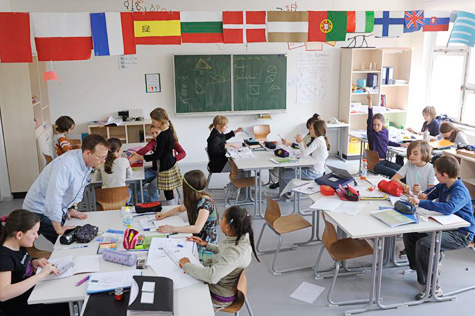At GoConqr (formerly ExamTime), we believe that learning is not just about passing exams. For us, learning is about acquiring knowledge and life-skills that can be applied to solving real problems. This idea is why we love PBL (Project-Based Learning) and the reason why today, we have invited Suzie Boss, an expert in this arena, to tell us more about PBL and how it can help students and teachers.
Hi Suzie, thank you for joining us today! Before we start, please tell us a bit about yourself and your experience with PBL.
 I’ve been immersed in PBL for more than a decade now as a writer and consultant. I’ve written several books about PBL and innovation in education, blog about PBL for Edutopia.org, and consult with the Buck Institute for Education as part of their National Faculty.
I’ve been immersed in PBL for more than a decade now as a writer and consultant. I’ve written several books about PBL and innovation in education, blog about PBL for Edutopia.org, and consult with the Buck Institute for Education as part of their National Faculty.
However, my introduction to PBL goes way back to when I was teaching journalism. It just made sense, given my own background in publishing, to approach the subject by having students work in teams, write for an authentic audience, give and receive feedback, and use technology to publish their work. I didn’t yet know the language of PBL, but that’s what we were doing!
What is PBL?
In a nutshell, PBL is an instructional approach in which students learn by doing. An interesting, open-ended driving question kick-starts the inquiry process. Students research and investigate to find out what they need to know, perhaps consulting with experts from outside the classroom and using a variety of digital tools as part of their investigation. They typically work in small teams to generate potential solutions or responses, and then share their final work with an authentic audience.
What are the benefits of this learning approach?
The most immediate benefit is increased student engagement. We know from research that students become less engaged in learning the longer they spend in school. PBL offers a way to reverse that trend by giving students the opportunity to dig into real-world issues and challenges that matter to them and their communities.
They aren’t just answering questions at the end of a chapter. They’re asking their own questions and then using the skills of an effective problem-solver and creative thinker to generate answers. Through these experiences, students also gain a deep and lasting understanding of academic content. Learning is “stickier” when students don’t just learn content for a test or assignment, but apply what they know to create something new.
What academic level and subjects is PBL most suited for?
PBL works across grade levels and subject areas. I’ve seen it used from the primary grades into post-secondary education and in subjects ranging from science to literature to PE. Although projects can be confined to one subject, PBL lends itself to cross-disciplinary learning. That’s because projects are grounded in real-life situations that aren’t neatly confined to content silos.
Could you share any examples of success stories using this approach?
So many! Recent examples include high school government students advocating before their city council for a local ban on the sale of assault weapons. Students chose the issue, after extensive research. Their teacher’s goal: “I didn’t want students to read about citizenship. I wanted them to be citizens.”
At the elementary level, students presented their zoo with examples of redesigned exhibits that would be more hospitable to animals and also more engaging for children visiting the zoo. Along the way, students learned about habitats, ecosystems, animal behavior, and architecture.
I’ve just watched some middle-school students put their creativity and writing skills to work by designing “audio postcards” that tell the story of a place or travel experience through words and sounds.
What is the role of the teacher/tutor in a PBL process?
Good PBL experience does not happen by chance. The teacher plays a critical role in designing experiences that connect to learning goals; managing the learning process and responding on the fly to make adjustments; and assessing learning throughout. It’s a tall order, especially for teachers who are new to PBL.
What’s the feedback of students that have tried PBL?
This is admittedly a different way of learning for many students. Some need time to get used to learning in new ways, especially if their prior experience has been very teacher directed. Many need teacher guidance about how to collaborative effectively, think critically, and unleash their creativity. Most students tell me that, once they’ve had a good PBL experience, they don’t want to go back to textbook-and-test instruction. PBL gives them more of a voice in their own education, and students value that.
How can teachers introduce PBL into their teaching routine?
I encourage PBL newcomers to start small with a short-term project. They might redesign a unit they already teach into PBL, or adapt an existing project from an online PBL library (many good examples at www.bie.org). Or they might team up with a colleague who has more experience with PBL.
Whatever their entry point, teachers will benefit from reflecting throughout the process. What’s challenging? Where are the bright spots? How do students respond? How will you modify the project next time?
What do you think of the use of Mind Maps during a PBL process?
Mind Maps are just one good example of existing and familiar resources that teachers can bring into PBL. It’s worth remembering that you don’t put aside everything you know about good teaching just because you’re doing a project! Rather, think about when those tools and activities will fit into your project calendar.
Why should teachers try PBL?
The benefits for students are compelling: deeper learning, more engagement, perhaps some real impact in their communities. But research also tells us that teacher satisfaction increases with PBL. There are some caveats—professional learning opportunities and time for teacher collaboration are two of the preconditions that help PBL take hold. But once teachers gain experience with this way of teaching and learning, they often tell me, “I’ll never go back.”
Thank you for sharing your expertise and tips with us today Suzie! We hope that it will be useful for many teachers who are looking into trying PBL in their classroom!
Suzie Boss is an author of several books, including Reinventing Project-Based Learning and Real-World Projects, and an international consultant on PBL.
Jens Rötzsch / CC BY-SA 3.0 via Wikimedia Commons
OregonDOT / CC BY 2.0
GoConqr is an online learning platform with tools that teachers can use to implement project-based learning (PBL) into their classroom. Our mind mapping, notes and other tools can be used by teachers to encourage students to engage in this type of learning. Get started with GoConqr here, it’s free.
About the GoConqr Blog
Our blog is part of GoConqr, a Free Learning Platform for Creating, Sharing & Discovering Learning Resources that help students and teachers achieve their learning objectives. Click here to start creating Mind Maps, Flashcards, Notes, Quizzes, Slides Flowcharts & Courses now!







